9 Phone Tree Templates + How To Build Your Own

In a world dominated by virtual communication, the telephone remains the most widely used channel — nearly 3 out of 4 customer interactions happen via phone call. This steadfast preference emphasizes the importance of optimized phone-based communication. One aspect of phone calls businesses should consider improving is phone trees, which serve as the first point of contact between a customer and a business, setting the tone for the entire interaction.
Whether you're looking to revamp your existing phone tree or implement a new one, the phone tree templates in this post will guide you in crafting a system that resonates with your customers and fosters better brand experiences.
What is a phone tree?
A phone tree is an automated phone messaging system that helps route calls to the correct department or service based on selections made by the caller. Most businesses use interactive voice response (IVR) technology to create and manage their phone tree.
The purpose of a phone tree is to streamline communication processes. It reduces the need for manual call routing and performs simple tasks without agent intervention — making operations that much more efficient. A phone tree does not eliminate the need for human agents but instead, it relieves them of tedious and simple duties, like answering repetitive questions and collecting preliminary caller information, through automation.
There are two types of business phone trees: traditional ones that rely on callers to navigate using keypad inputs, and more advanced versions that use speech-recognition software to respond to voice commands. By utilizing either type of phone tree, businesses can save time and resources while improving the overall experience for callers.
9 phone tree templates
A well-designed phone tree strikes the right balance between functionality and user-friendliness. Use these templates as inspiration to design a phone tree that delights customers instead of annoying them.
Basic phone tree template

Designed for businesses with simple call-routing needs, a basic phone tree template has just a few options to direct callers to various departments or agents without overwhelming them with choices. It's perfect for small organizations or those just starting to automate their call operations.
Download the basic phone tree template
Detailed phone tree template

A detailed phone tree template is more comprehensive, making it suitable for larger companies with many departments and services. It's structured to handle complex call flows, providing detailed options like department-specific inquiries or support for multiple products.
Download the detailed phone tree template
Multi-location phone tree template
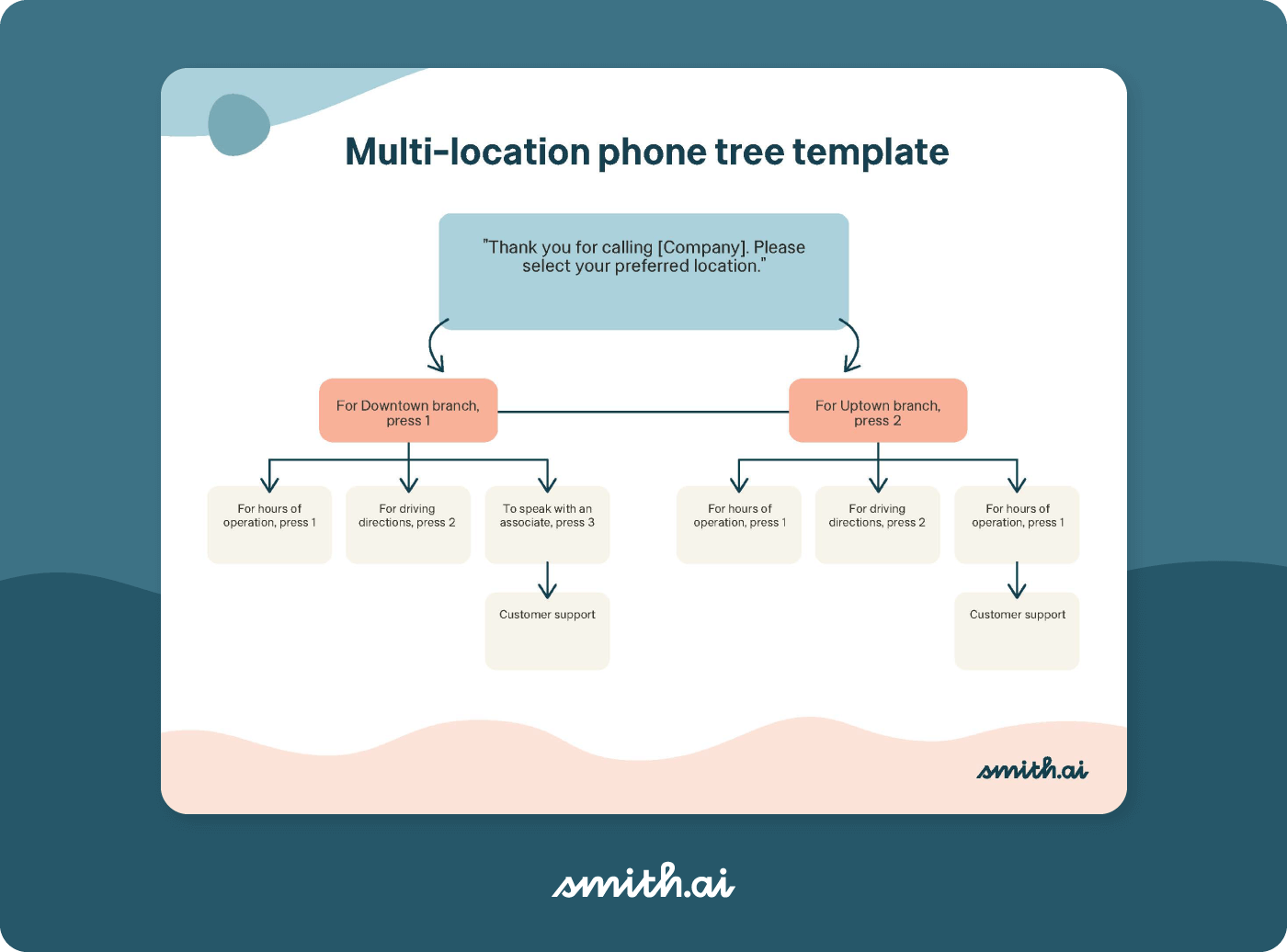
If your business operates multiple locations, use a multi-location phone tree template. It asks callers to select their closest location or preferred branch, ensuring they get personalized help from a local team.
Download the multi-location phone tree template
Sales phone tree template

Sales-oriented businesses can benefit from the appropriately named sales phone tree template. Typical prompts offer product information and current discounts/promotions or connect potential customers directly to sales teams.
Download the sales phone tree template
Emergency phone tree template

Unlike the other templates, an emergency phone tree template is for outbound calls. Instead of handling numerous incoming calls, organizations use an emergency phone tree as an incident management tool to streamline crisis communication. It enables companies to send quick updates regarding urgent issues like emergency shutdowns or sudden schedule adjustments.
Download the emergency phone tree template
After-hours and voicemail phone tree template
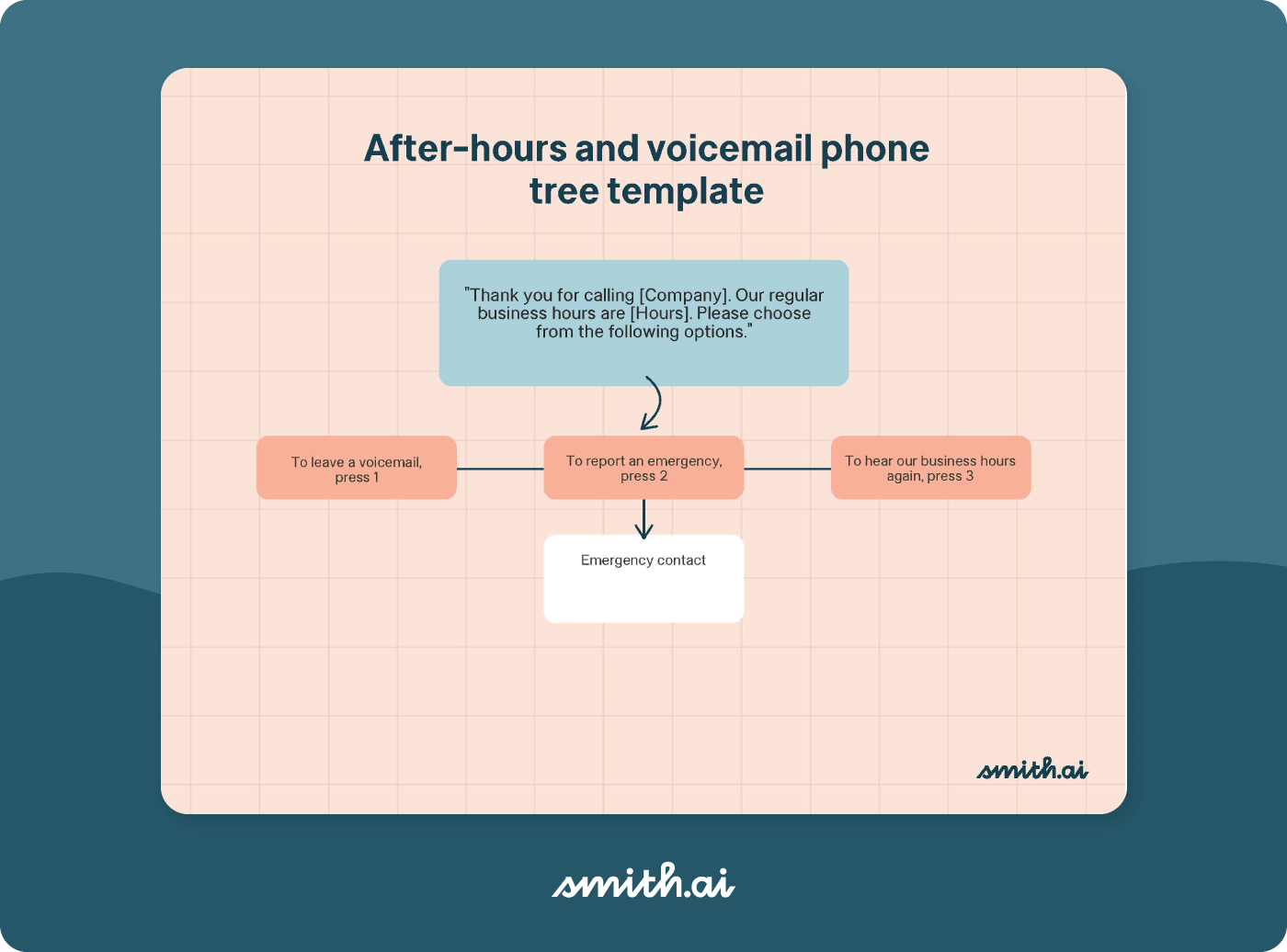
An after-hours and voicemail phone tree template takes over outside standard business hours. It lets customers leave voicemails and provides information like hours of operation or emergency contacts.
Download the after-hours and voicemail phone tree template
Customer support phone tree template
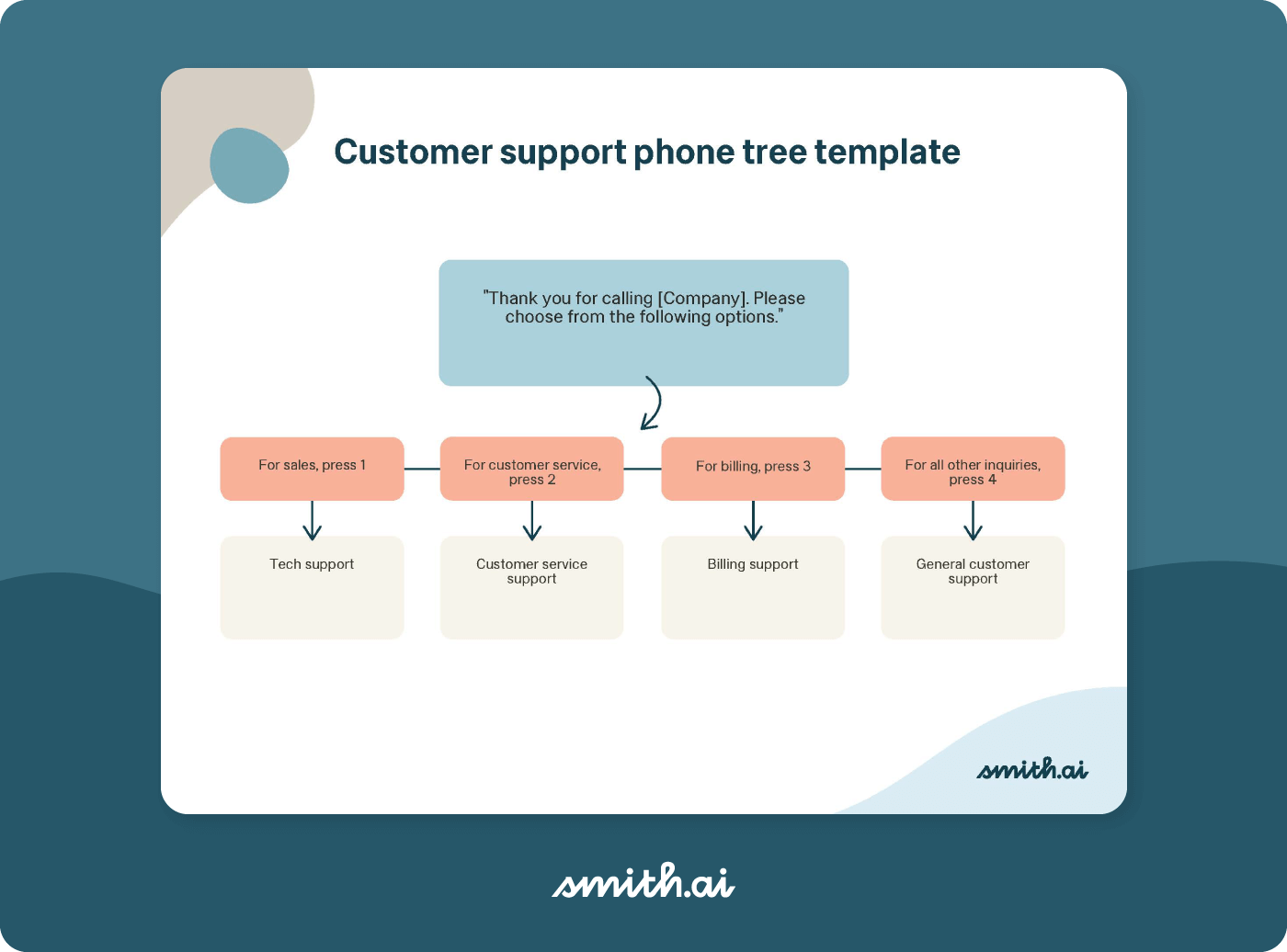
Specifically designed to assist existing customers, a customer support phone tree template offers options for troubleshooting, account information, or speaking to customer service staff. Teams can use it to sort out any customer questions or issues quickly and effectively.
Download the customer support phone tree template
Retail phone tree template
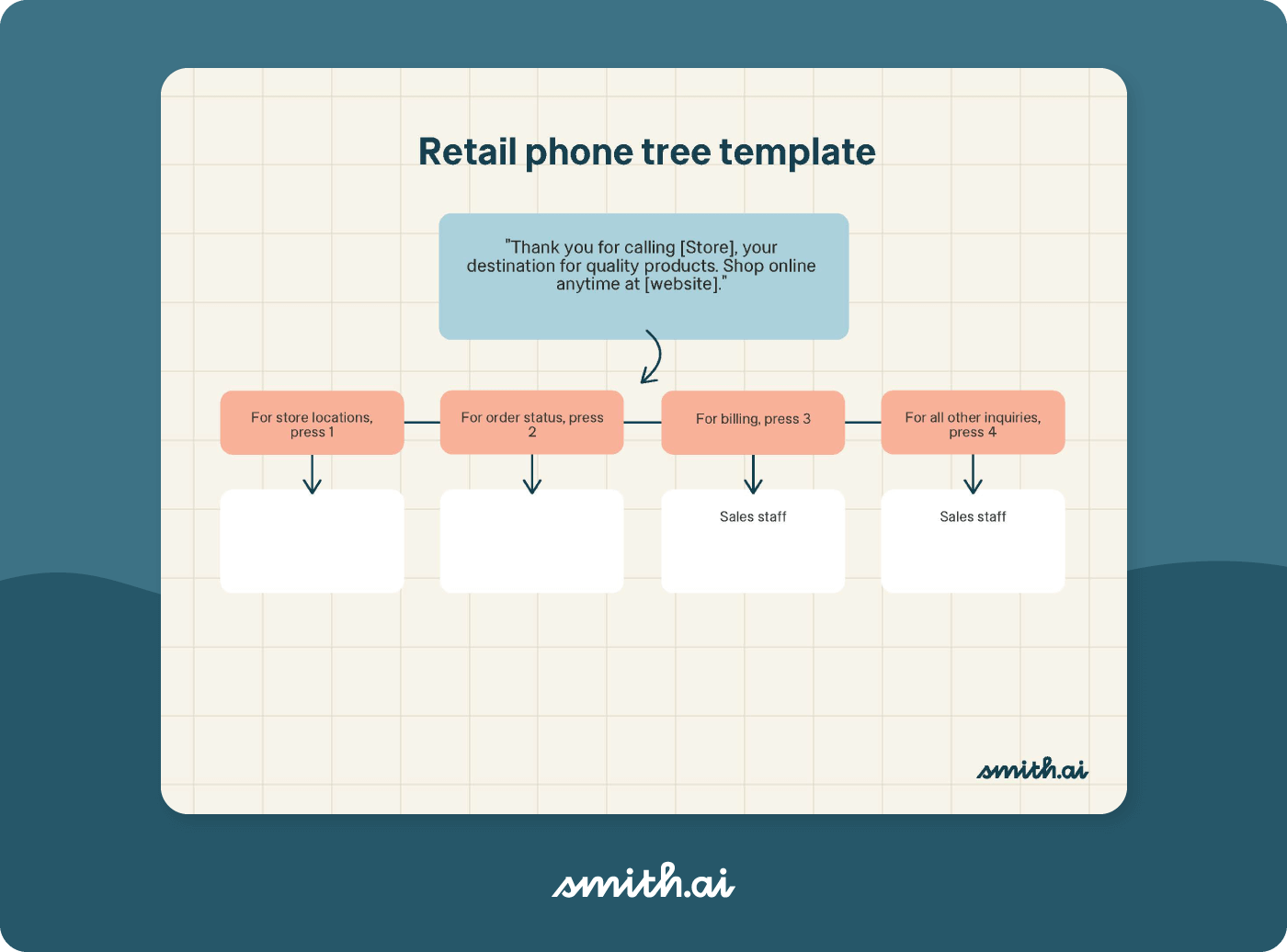
Tailored for retail businesses, the retail phone tree template provides options for store locations, product availability, and talking directly with a customer service agent for questions about purchases. It aims to improve the shopping experience through convenient access to pertinent information.
Download the retail phone tree template
Service-based business phone tree template

A service-based business phone tree template is a great solution for businesses that rely on appointments — think salons, HVAC technicians, dental offices, consultancy firms, or law offices. This phone tree guides callers to schedule appointments, ask about services, or speak directly with a service provider.
Download the service-based phone tree template
The importance of using a phone tree
For any business, it's important to have a competent answering service in place to manage high call volumes. Using a phone tree offers several key advantages:
- Routes callers efficiently: A phone tree prompts callers to select options that direct them to the correct agent or department based on their needs, saving time for both customers and agents.
- Minimizes customer frustration: By providing clear menu options and routing callers properly the first time, phone trees reduce the frustration of being transferred multiple times or waiting on hold endlessly.
- Increases first-call resolution: A thoughtfully constructed phone tree can solve many issues customers often report during their initial call, eliminating the need for follow-up contact. This results in higher customer satisfaction.
- Reduces operational costs: An automated phone tree lowers costs by decreasing the number of calls that require live agent assistance and allows calls to be answered 24/7. It also frees up employees to focus on more complex customer issues.
- Improves call volume handling: A well-built phone tree can support a high volume of calls simultaneously without compromising the customer experience. This ensures no call goes unanswered, even during peak times. Additionally, it enables teams to effectively prioritize incoming calls and swiftly direct high-priority issues to the appropriate agents.
How to create an effective phone tree
Creating a business phone tree might require some careful thought and hard work, but the benefits can be massive. Here's how to design a handy phone tree for your organization:
1. Put yourself in customers' shoes
It's easy to base the phone tree on your company's structure rather than tailor it to customer needs. However, the menu should aim to help callers achieve their intended goal in the shortest time using as few selections as possible.
A customer-centric phone tree considers what callers need help with, regardless of which part of your organization will fulfill it. The idea is simple — customers want something done without concern about who handles it within the company. They shouldn't have to figure that out themselves, so presenting them with options that align with their needs is ideal.
2. Design and structure your phone tree
Take a moment to decide how many levels are necessary for your business. A smaller company might only need one or two layers, while larger corporations could require more. Establish contacts at each stage within every branch to ensure appropriate call distribution.
Identify major departments or teams within your organization, then decide on the sequence in which they should appear. Pay attention to the areas of your business that receive the highest call volume and prioritize them accordingly.
Think about the most frequent transactions and map out customer paths through the menu structure based on these interactions. Is it easy to follow? Are there ways to simplify their experience, further reducing time spent navigating menus?
3. Test and iterate call routing
Once you've mapped out your phone tree, the next step is to put it through its paces. Double-check that all routes and choices work as they should. To do so, make a few test calls to confirm whether callers can easily find their way to the correct department or person without running into dead ends.
Think of yourself as a customer calling in for various reasons as you dial into your new phone tree. Do all options connect with a live agent or an appropriate recorded message? Make sure there are fail-safes in place if an incorrect option is selected. Involving colleagues, friends, or family members who haven't heard the menu before can also be beneficial — they might point out confusing aspects or difficulties that were not obvious to the phone tree designer.
Based on these results, fine-tune where required. You may need to re-record prompts, include more options, or redirect some choices. Modifying the call flow now is far simpler than doing it after launch.
4. Train your employees
To make your phone tree as effective as possible, employees need to know it inside and out. Take the time to walk them through all of its various options so they understand what callers experience. Have your team familiarize themselves with the system as mock callers. This way, they can better anticipate potential questions and pinpoint parts that may be confusing.
At this point, you should also ensure your CRM and other necessary technologies are set up to gather call data and understand customer needs. Callers shouldn't have to repeat their frustrations or purchase details every single time.
Corresponding training sessions should always accompany any modifications made to the phone tree. Continuously keep reference materials updated and easily accessible for all staff. Regular education will reduce confusion for employees and clients alike.
5. Track and analyze usage
Once your phone tree is operational, it's crucial to analyze its functionality. Keep an eye on your call logs to identify which options see the most action. Pay attention to:
- Options that are seldom or never selected: You may be able to omit these for a smoother caller experience.
- Instances where callers often hang up or choose the "return to main menu" option: This may indicate signs of confusion or frustration. Evaluate these prompts and aim to make them more straightforward.
- Times when certain options gain popularity during specific hours or days: Consider adjusting the menu order to prioritize frequently used choices during peak calling times.
Optimizing your phone tree through data-driven tweaks can significantly boost caller experience, so don't hold back from making adjustments when necessary. Not only will usage patterns become clearer over time, but you'll also create a phone tree that genuinely meets the needs of all customers.
Phone tree template best practices
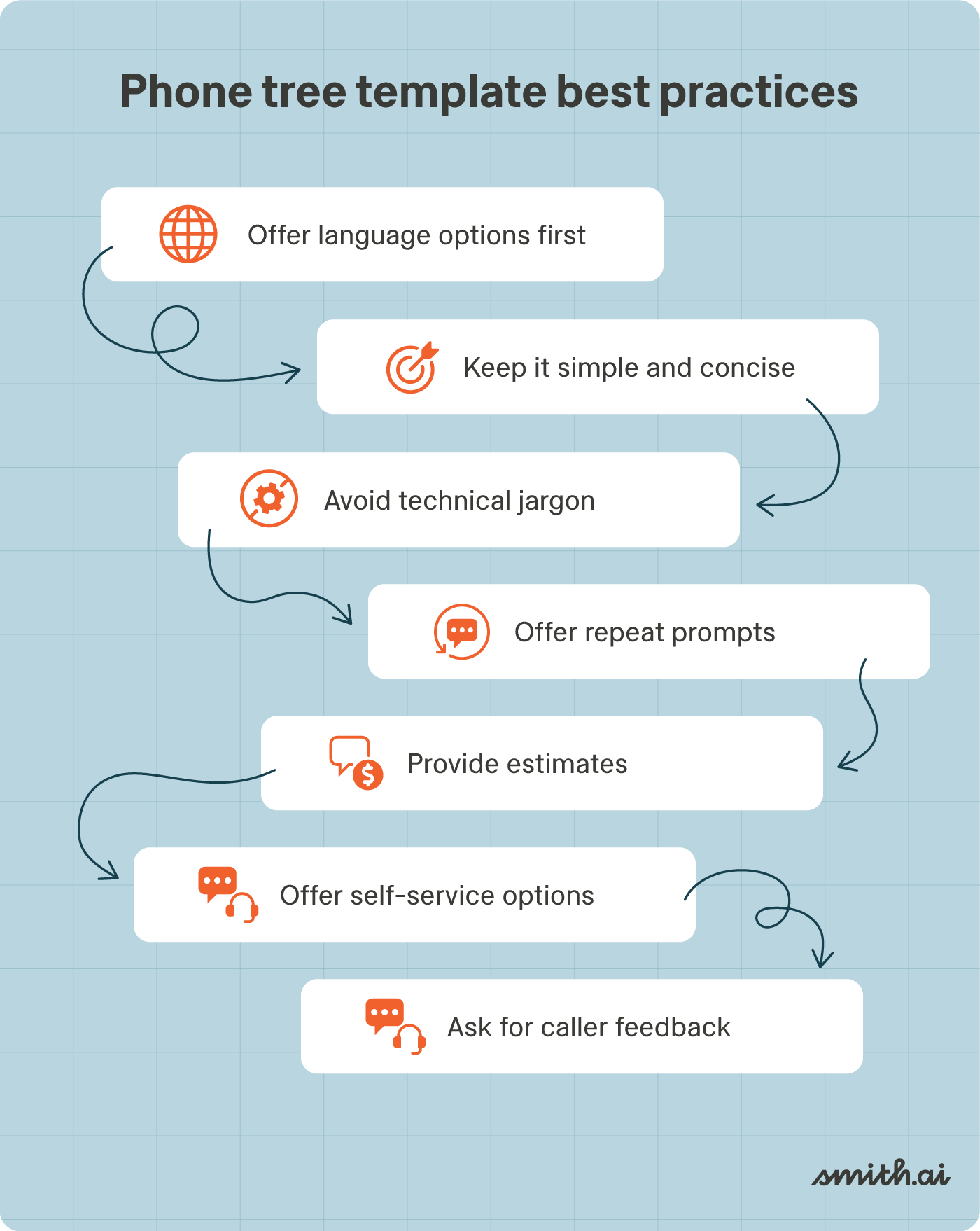
Businesses that use a phone tree often have higher customer satisfaction. In order for this to be successful, however, it is extremely important to create a user-friendly phone tree menu. Here’s how:
- Offer language options first: The first prompt in your phone tree should ask the caller to select their preferred language. This makes your phone tree accessible to more customers and provides an inclusive experience.
- Keep it simple and concise: Try to limit the menu options to three at a time, and don't make callers go more than three steps deep into your phone tree. This will still give them 27 possible transfer points. If you break this guideline, there is a high probability that callers will disconnect before reaching an agent.
- Avoid technical jargon: A large company's tech support department, for example, might have options like “Press 1 for hardware issues, press 2 for network problems,” and so on. This can get confusing for those who are not tech-savvy. Straightforward options, such as “Press 1 if your computer or other hardware isn't working correctly, press 2 if you're having trouble with your network connection,” are much easier for callers to understand.
- Offer repeat prompts: Not all callers will understand or remember the menu options the first time. Repeat the main menu prompts after three to five seconds of silence. This simple step can reduce frustration and hang-ups.
- Provide estimates: Let callers know approximately how long wait times are for live agents. This allows the caller to choose the best option for their needs and set the right expectations.
- Offer self-service options: In addition to speaking to a live person, provide callers with self-service alternatives through touch-tone commands or speech recognition. These could include:
- Checking order status or account balance
- Making a payment
- Accessing store hours or contact information
- Tracking a delivery
Self-service options allow simple tasks to be completed quickly without waiting on hold to talk to an agent. They also reduce call volume to live agents, so wait times are shorter for complex issues.
- Ask for caller feedback: Setting up a system to collect feedback once a call wraps up can provide invaluable insights. Allow customers to share their thoughts through a quick survey at the end of each call. This firsthand feedback helps you consistently fine-tune your phone tree and overall customer service.
Streamline incoming calls with Smith.ai
Whether you're a small business or a large corporation, using a phone tree template to integrate an IVR menu into your customer service strategy can lead to significant improvements in both customer satisfaction and resource management.
But why stop at just a phone tree? Elevate your customer service experience with Smith.ai's virtual receptionists. Our 24/7 live agents can work alongside your phone tree, ensuring your callers always receive a human touch.
Get started by booking a free consultation to learn how Smith.ai can transform your customer experience.
Related Posts

















.svg)
